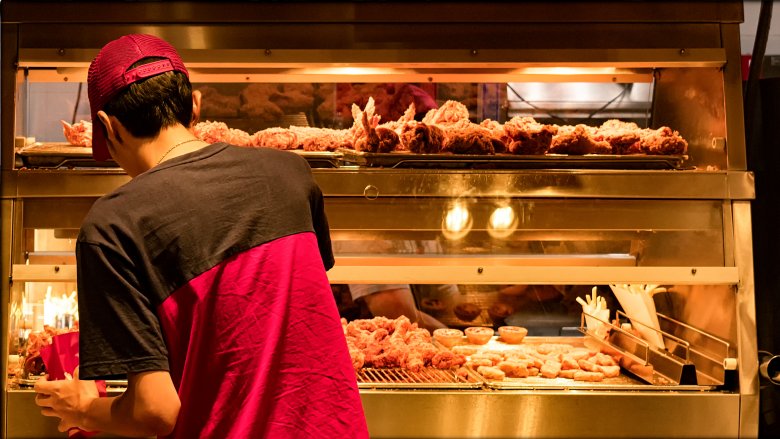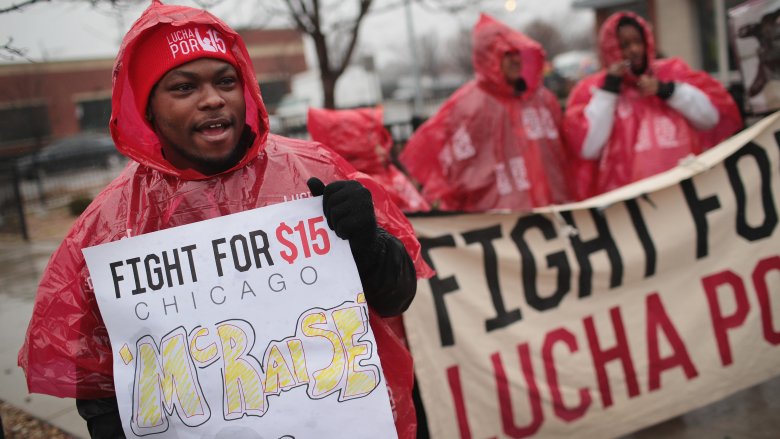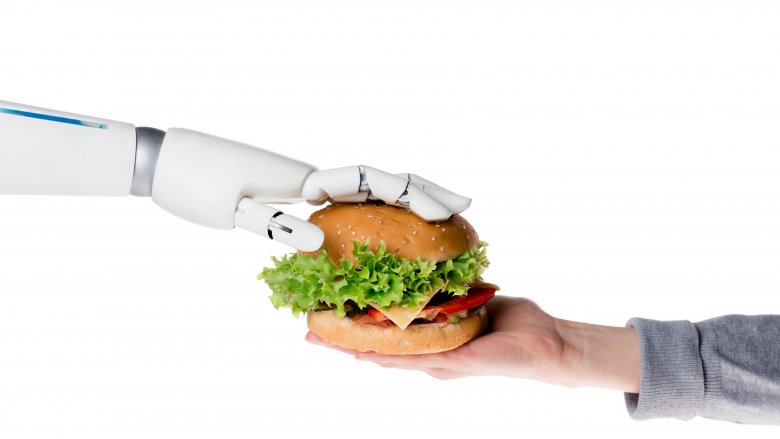Things You Don't Know About Fast Food Employees
Fast food is ubiquitous in America. Ask many people from abroad what they think Americans eat, and their first answer will be "McDonald's." It turns out they're not too far off!
Around 80 percent of us eat fast food at least once a month and half of us swing through the drive through weekly — even though most report that they think fast food isn't good or good for you. Still, there's something about fast food, be it the convenience or the salty-fatty-sweet deliciousness of it all, that keeps us coming back for more.
So, what about the people who are there day and night, frying our chicken nuggets, placing lettuce on our burgers, and filling our cups with shakes and soda? There's a lot you might not know about the people working behind the scenes to get you your food in record time. Read on to find out what it's really like to be a fast food employee.
There are more than 3.7 million in the US alone
You may think that fast food employees are a small group, but it turns out there are more fast food workers in the US than you might think. Overall, there are about 13.19 million people who work in the restaurant industry in the US, and a whopping 28 percent of those employees work for fast food restaurants.
As of 2018, there are more than 3.7 million fast food employees currently working in the United States alone, a number that's been steadily growing since 2010, when it dipped to 3.5 million.
This means that, while most people think of it as a last-resort job worked by high schoolers, there is a large and diverse workforce behind your favorite fast food burgers, tacos, and fried chicken. So the next time you crack a joke about flipping burgers, you might want to think again — someone who's worked in the fast food industry is likely sitting nearby.
They make about $13,500 a year
For all the talk about the Fight for $15 — an activist campaign calling for fast food worker wages to be raised to $15 per hour — most fast food workers still aren't exactly raking it in. The average annual wage of a fast food worker is just $13,500 a year. This number is up from just $12,850 in 2002, but when you look at the long term gains — just $642 over 14 years — it's clear that the wages in the industry haven't kept up with other economic trends.
Considering that the cost of living goes up an estimated 1.5 percent each year, fast food employees are actually making less money now than they were a decade and a half ago. Their actual wages have increased, but the double whammy of inflation and the rise in cost of consumer goods and rent has left many of them struggling to get by. Meanwhile, huge fast food companies are still raking in the cash. It's starting to make sense why so many fast food workers are campaigning for wage increases, isn't it?
More than half have a second job
Now that we have a little better of an idea of how much fast food employees are making on average, it probably won't come as too much of a surprise that more than half of workers at fast food restaurants have to get a second job to make ends meet.
There's an awful stereotype that working at a fast food place is a job for lazy people, but it turns out that many of these people are incredibly hard workers, who take on multiple jobs so they can provide for themselves and their families.
Sadly, most major fast food chains are more than well aware that they aren't paying their employees enough to get by. In 2013, McDonald's got a ton of flack for launching a financial planning guide for its employees that included a sample budget that assumed their employees we working full time at the restaurant, and that they had a second job. Otherwise, there just wasn't a way to make the numbers add up.
They're older than you might think
There's a stereotype that most fast food employees are teens just looking to make pocket money or to save up for college. If that were the case, maybe the low pay wouldn't be such an issue. But in fact, more than 40 percent of the fast food industry's workforce is made up of people 25 years or older, with the average age hovering around 29 years old. In contrast to the myth that most fast food workers are uneducated, about a third of them have completed some form of higher education, too.
Once you start to realize that most fast food workers are adults just like the rest of us, it's no surprise to learn that 26 percent of fast food employees have kids. This makes the stats about their average income and the necessity to hold down more than one job even more dismal. Putting yourself through school on a fast food income is hard enough — trying to raise a family on that budget seems almost impossible.
It's hard for them to climb the ladder
We're a "bootstraps" nation, one that assumes you can work your way up from the bottom as long as you put your nose to the grindstone and put in the hours. Unfortunately, in the fast food industry, employees are more likely facing a road to nowhere.
That's because, put simply, the numbers just don't add up. A whopping 90 percent of workers in the fast food industry are cashiers or line cooks, while only 9.9 percent gain low-level supervisor titles that make them around $13 an hour.
Even more dismal? Just 2.2 percent of all fast food jobs are at the managerial level or in corporate positions, jobs which millions of employees are in competition for. And, though companies like McDonald's share franchisee success stories about employees who work their way from cashier to owner, just one percent of all fast food workers actually own a franchise — it's incredibly rare. So much for working your way up.
More than half depend on public programs to get by
Now that we're getting a clearer picture of working conditions at fast food restaurants, this next bit of info probably won't surprise you.
Because of low wages, almost half of fast food workers rely on some form of public assistance, like TANF (temporary assistance for needy families) and SNAP (supplemental nutrition assistance program), even as more than half of them are working two jobs. This is compared to just 25 percent of the general workforce.
Overall, almost a fifth of fast food workers are living below the poverty line. All of this adds up to about $7 billion in welfare payments annually to fast food employees. Instead of the companies they work for paying them a living wage and giving them benefits, the livelihood of these employees falls on taxpayers. Unfortunately, because of the demonstrated trend of fast food wages not increasing proportionally with inflation and cost of living, this number is likely to continue growing.
Only 13 percent qualify for employer health benefits
Just when you think it couldn't get any worse, here come the statistics on how many fast food workers are eligible for employer health care benefits.
The fact of the matter is that most fast food employees don't receive any health benefits at all. While about 40 percent of the general workforce receives no employer health benefits, the same is true of a full 87 percent of fast food employees, more than twice the rate of the general population.
This means that they're forced to either pay out of pocket for medical expenses, or need to rely on public assistance to get the health care they need. This is even more difficult for the 26 percent of fast food workers who have kids they're trying to provide for, too.
One of the ways fast food companies avoid paying benefits for their employees is by scheduling them to work just slightly less than full time. So, though many of these workers have two jobs, often time they're scheduled at slightly less than full time hours both places, meaning they never qualify for health insurance or other benefits (like family or medical leave, worker's comp, or guaranteed time off for things like voting or military service).
Almost 80 percent of fast food employees have suffered multiple injuries at work
Flipping burgers (or rolling burritos, making sandwiches, or frying chicken) ain't easy. In fact, it's downright dangerous, and a majority of fast food employees (87 percent) get injured on the job at least once a year, while 78 percent report getting injured multiple times on the job.
The sizzling grill and bubbling fryer are the cause of most injuries. 79 percent of fast food workers report being burned at work, and 73 percent of those workers received multiple burns. This means that more than 58 percent of fast food workers have been burned repeatedly on the job, which makes wisecracks about serving fries seem a little cruel.
Other injuries include getting a cut (67 percent of workers), getting hurt while lifting or carrying heavy items (34 percent), or, even, being assaulted on the job (12 percent).
Workers have reported that the main culprit behind these injuries is understaffing and pressure to work as quickly as possible. Shockingly, 36 percent of fast food employees also say that their place of work lacks a fully stocked first aid kit. Almost half of burn victims were offered no appropriate treatments for their injuries on the job, and a third said that their manager recommended using items like condiments (yes, really) to sooth the burns instead of burn cream.
Well, at least they have health insurance! Oh, wait ...
They probably won't work there for long
So, is working at a fast food restaurant a dream job? Not exactly. While the perks (free tacos and fries! woohoo!) might initially seem like a benefit, most employees find that their relationship with their place of work quickly sours.
The fast food industry has a yearly employee turnover rate of 150 percent. This means that every year, they fully replace their workforce, and then replace half of those replacements.
This says a lot about the industry as a whole. For one, it means that these jobs offer little to their employees, giving them very few reasons to stick it out (see: low pay, no benefits, no upward mobility, high rate of injuries). But it also means that companies have little incentive to change the conditions at their stores.
Employees end up leaving before they can petition for change, because staying to fight for improvements just isn't financially worth it. The fast food companies have a seemingly endless supply of workers who are just trying to make money and will keep applying for these jobs — and thus, no incentive to make their companies a more appealing place to work.
They might get replaced by robots
At the very least, one could say that something redeeming abou the fast food industry is that it supplies jobs for 3.7 million people. But that could soon change.
More and more, under the claim that rising labor costs are affecting their bottom line, fast food chains are automating their restaurants and replacing workers with robots, computers, and self-ordering kiosks.
Ed Rensi, a former CEO of McDonald's USA, says that companies are moving in this direction for several reasons. "It's not only the minimum wage, it's the work rules, it's the joint employment requirement, now the franchisors are responsible for the labor practices of franchisees. It's all nonsense, it's over-regulation."
Instead of working to improve conditions for their workers, many of these corporations have decided that it's just too much trouble. Ordering can be done at kiosks, and soon enough, food prep could be done by robotic machines. Sure, it'll probably reduce the amount of workplace injuries in the fast food industry, but it also means that millions of people could lose their job.
It all gives you something to think about the next time you go through the drive-thru, doesn't it?










